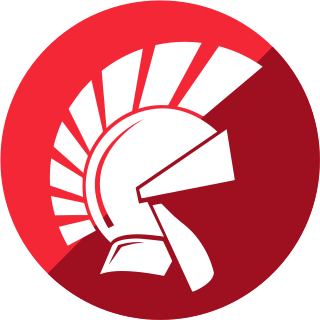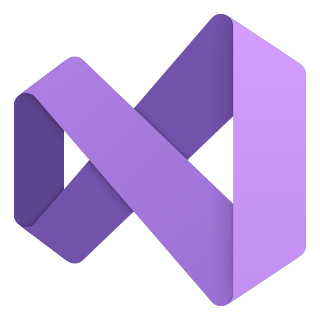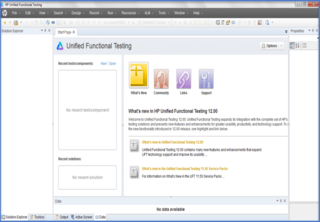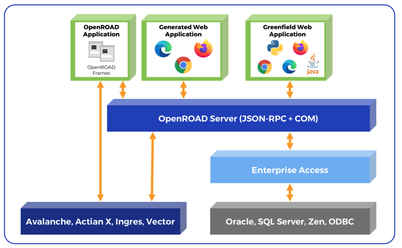VBScript is an Active Scripting language developed by Microsoft that is modeled on Visual Basic. It allows Microsoft Windows system administrators to generate powerful tools for managing computers without error handling and with subroutines and other advanced programming constructs. It can give the user complete control over many aspects of their computing environment.
In computing, cross-platform software is computer software that is designed to work in several computing platforms. Some cross-platform software requires a separate build for each platform, but some can be directly run on any platform without special preparation, being written in an interpreted language or compiled to portable bytecode for which the interpreters or run-time packages are common or standard components of all supported platforms.
Ingres Database is a proprietary SQL relational database management system intended to support large commercial and government applications.

Delphi is a general-purpose programming language and a software product that uses the Delphi dialect of the Object Pascal programming language and provides an integrated development environment (IDE) for rapid application development of desktop, mobile, web, and console software, currently developed and maintained by Embarcadero Technologies.
Btrieve is a transactional database software product. It is based on Indexed Sequential Access Method (ISAM), which is a way of storing data for fast retrieval. There have been several versions of the product for DOS, Linux, older versions of Microsoft Windows, 32-bit IBM OS/2 and for Novell NetWare.
Oracle Forms is a software product for creating screens that interact with an Oracle database. It has an IDE that includes an object navigator, property sheet, and code editor that uses PL/SQL. It was originally developed to run server-side in character-mode terminal sessions. It was ported to other platforms, including Windows, to function in a client–server environment. Later versions were ported to Java where it runs in a Java EE container and can integrate with Java, and web services that can be launched from a URL. Recent versions provide a means to run the forms from a desktop computer without requiring a browser.

Uniface is a low-code development and deployment platform for enterprise applications that can run in a large range of runtime environments, including mobile, mainframe, web, Service-oriented architecture (SOA), Windows, Java EE, and .NET. Uniface is used to create mission-critical applications.
Forté 4GL was a proprietary application server that was developed by Forté Software and used for developing scalable, highly available, enterprise applications.
LINC is a fourth-generation programming language, used mostly on Unisys computer systems.

JADE is a proprietary object-oriented software development and deployment platform product from the New Zealand-based Jade Software Corporation, first released in 1996. It consists of the JADE programming language, Integrated development environment and debugger, integrated application server and object database management system.
Servoy is a development and deployment platform for enterprise applications, written itself in Java, and which uses JavaScript as its scripting language. It can adopt the native look and feel of any platform or the web, using HTML5 and CSS code. Servoy was created from the start to make enterprise business application development easy. It has introduced many innovations for that purpose: the use of JavaScript instead of Java, a comprehensive development framework with building blocks that are added through drag and drop, a web client, etc.

Visual Studio is an integrated development environment (IDE) from Microsoft. It is used to develop computer programs including websites, web apps, web services and mobile apps. Visual Studio uses Microsoft software development platforms such as Windows API, Windows Forms, Windows Presentation Foundation, Windows Store and Microsoft Silverlight. It can produce both native code and managed code.

Micro Focus Unified Functional Testing (UFT), formerly known as QuickTest Professional (QTP), is software that provides functional and regression test automation for software applications and environments.
The Softwell Maker is an environment development. Designer uses visual forms and reports (WYSIWYG), business rules, and visually representing other actions using flowcharts.

db4o was an embeddable open-source object database for Java and .NET developers. It was developed, commercially licensed and supported by Actian. In October 2014, Actian declined to continue to actively pursue and promote the commercial db4o product offering for new customers.
ZK is an open-source Ajax Web application framework, written in Java, that enables creation of graphical user interfaces for Web applications with little required programming knowledge.
Versant Object Database (VOD) is an object database software product developed by Versant Corporation.

Actian Zen is an ACID-compliant, Zero-DBA, Embedded, Nano-footprint, Multi-Model, Multi-Platform database management system (DBMS) developed originally by Pervasive Software, which was acquired by Actian Corporation in 2013.

RStudio is an integrated development environment for R, a programming language for statistical computing and graphics. It is available in two formats: RStudio Desktop is a regular desktop application while RStudio Server runs on a remote server and allows accessing RStudio using a web browser.







